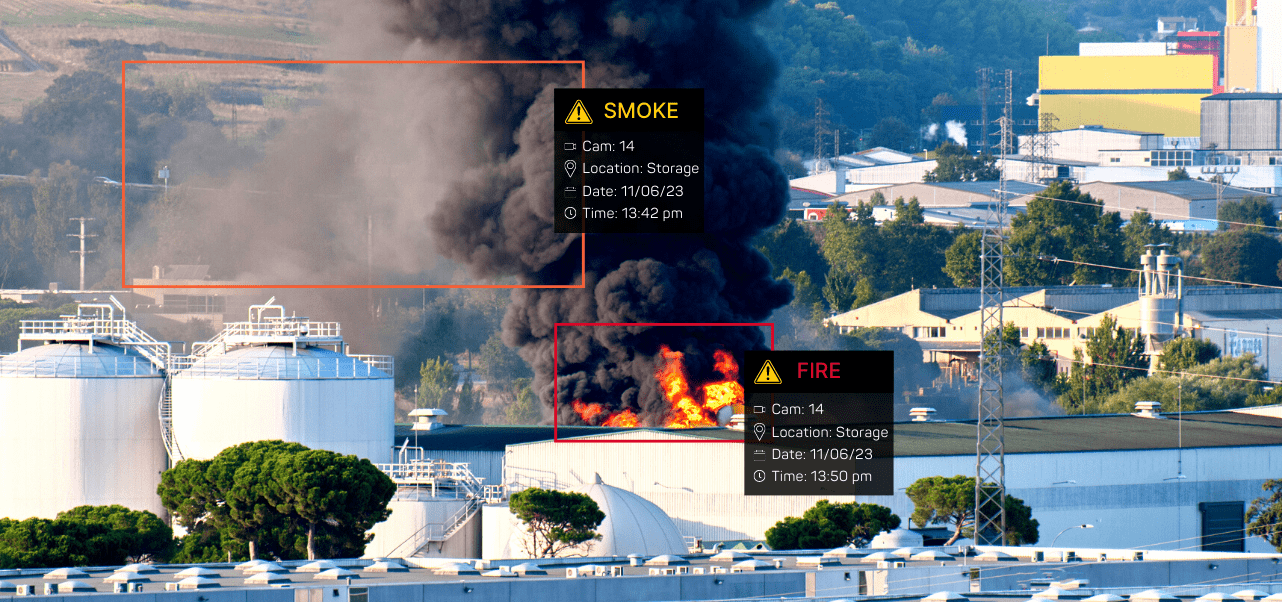Smoke & Fire Detection

What is a video-based smoke & fire detection system?
This approach provides several key benefits:
- Faster detection in wide or hard-to-reach areas such as warehouses, factories, forests, and construction sites
- Visual confirmation of incidents with recorded frames, timestamps, and location data
- Reduced false alarms thanks to advanced algorithms that differentiate smoke and fire from fog, steam, or lighting effects
- Seamless integration with existing surveillance infrastructure and alarm systems
By turning ordinary security cameras into smart fire detectors, a video-based system delivers early warning, rapid response, and enhanced safety, protecting both people and property from catastrophic fire damage.
Early fire detection
Identifying signs of smoke and fire on the industrial sites
Rapid response to the extreme situations
- 01 A smoke detector identifies and locates fire in a forest, at the factory, plant, or construction area
- 02 Sends an immediate notification that will prevent a fire at an early stage
- 03 Date, time, and place information helps quickly locate a fire on the territory
- 04 Business logic constructor
- 05 Cross-platform and multilingual interface
- 06 Prompt response to forest fires and their quick elimination
- 07 Improvement of the ecological situation by preserving flora and fauna
- 08 Identification of smoke and fire signs at industrial sites
Technical & Business Comparison
Technical |
Business / Operational |
|---|---|
|
Camera resolution, dynamic range, lens, IR / thermal capability |
Regulatory compliance (NFPA, UL) and acceptance |
|
Edge processing vs server / cloud architecture |
Return on investment: damage avoided, faster responses |
|
Model retraining, threshold tuning, false-alarm filtering |
Reduced manual verification, operational efficiency |
|
Integration (APIs, webhooks, PSIM / SCADA) |
Workflows: who receives alerts, how they act |
How video image fire & smoke detection works
01
Camera Selection & Placement: Pick cameras with proper resolution, dynamic range, and field-of-view for the area to be protected, from rooflines to forest edges or factory bays.
02
Pre-Processing: Algorithms normalize frames by removing lens artifacts, compensating for weather or noise, and adjusting for lighting changes.
03
Candidate Detection: Rule-based methods or deep-learning models highlight regions showing smoke-like or flame-like behavior, with temporal checks to avoid false alarms from shadows, clouds, or steam.
04
Confidence Scoring & Filtering: Thresholds, ensemble models, and contextual rules (fog, controlled burns) reduce false positives and improve reliability.
05
Alerting & Evidence: When detection confidence passes a set limit, the system generates an alarm packet with camera ID, timestamp, geo-position, and visual evidence, sending it to operators or triggering automated responses.
Why Choose Our Smoke & Fire Detection System?
Here’s what sets our system apart — built for real places, real risks, and real results:
- Early fire detection — catch small plumes of smoke or flickers of flame before they escalate
- Industrial & large-area awareness — spot fire and smoke signatures across factories, plants, forests, or construction zones
- Rapid response in extreme situations — alarms delivered instantly with location data
- Rich metadata & logging — date, time, and place accompany every detection
- Business logic & automation — customize triggers, thresholds, and downstream actions
- Cross-platform, multilingual UI — manage alerts from web, desktop, mobile across languages
- Ecological & safety benefit — preserve flora/fauna by stopping forest fires early
- Dual detection in industrial settings — optimized for large halls, sites, plants
As indicated by our tests, this solution catches events much earlier than traditional detectors in open spaces.
FAQs
These systems work in industrial sites, warehouses, retail malls, campuses, transport hubs, forests, and private properties. Unlike traditional detectors, they cover large open spaces and outdoor areas, making them ideal for both urban and rural settings.
The software connects to existing CCTV or IP cameras and analyzes live footage with AI algorithms. When smoke or fire is detected, the system instantly sends alerts with frames, timestamps, and location data to operators or mobile devices.
Yes — our findings show that video image detection systems spot smoke plumes and flames much earlier, especially in open or high-ceiling areas where traditional detectors often fail. This leads to quicker responses and minimized damage.
Absolutely. After conducting experiments with different environments, we discovered that modern AI fire detection systems can distinguish smoke from fog, steam, or lighting effects. This significantly reduces false positives compared to outdated solutions.
Yes. Through our practical knowledge, we’ve seen video smoke detection software used in forests and city outskirts to detect wildfires at their earliest stage, allowing emergency services to react before fires spread uncontrollably.
Definitely. The system is designed to integrate with existing surveillance infrastructure, alarm systems, and safety protocols, making deployment smooth and cost-effective.